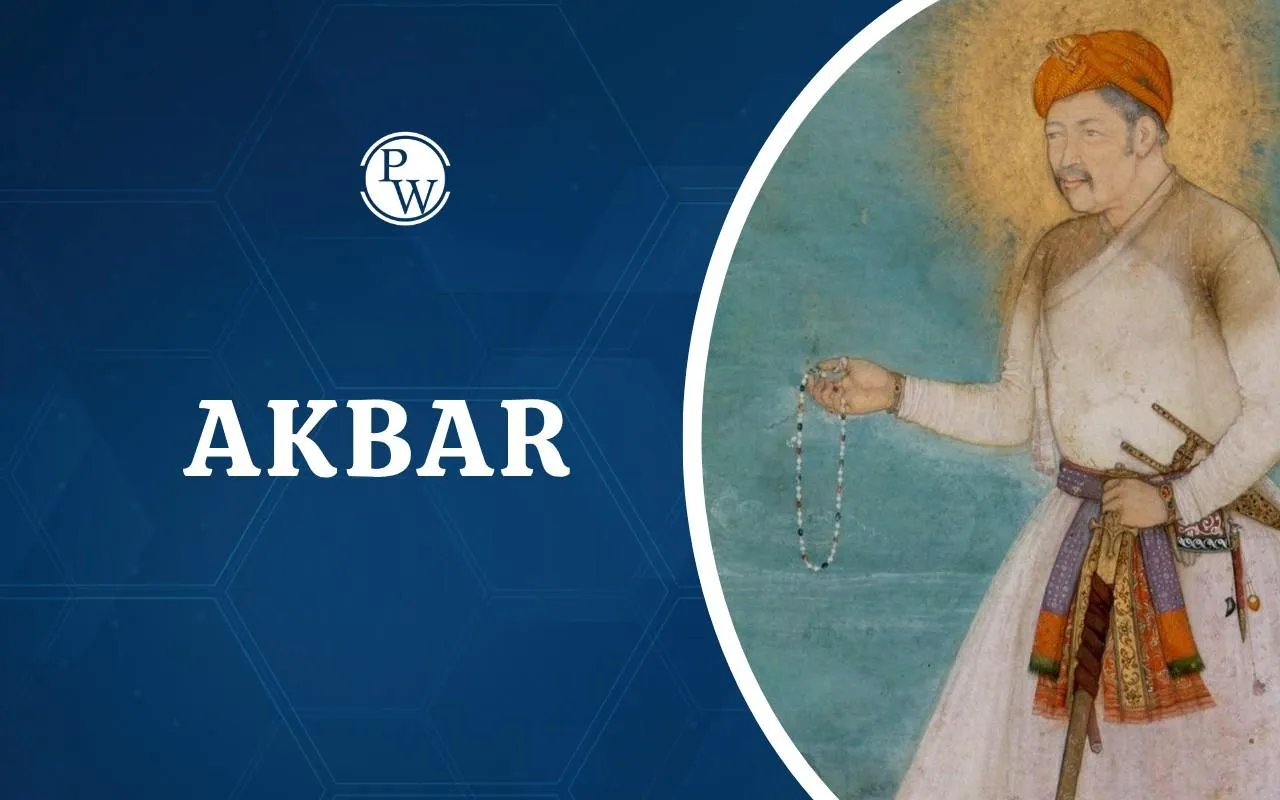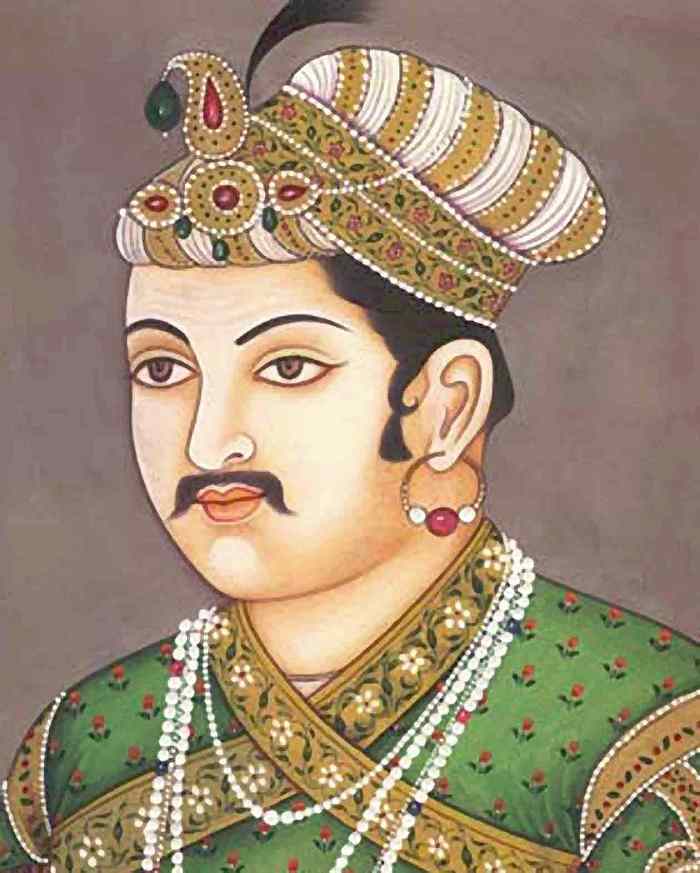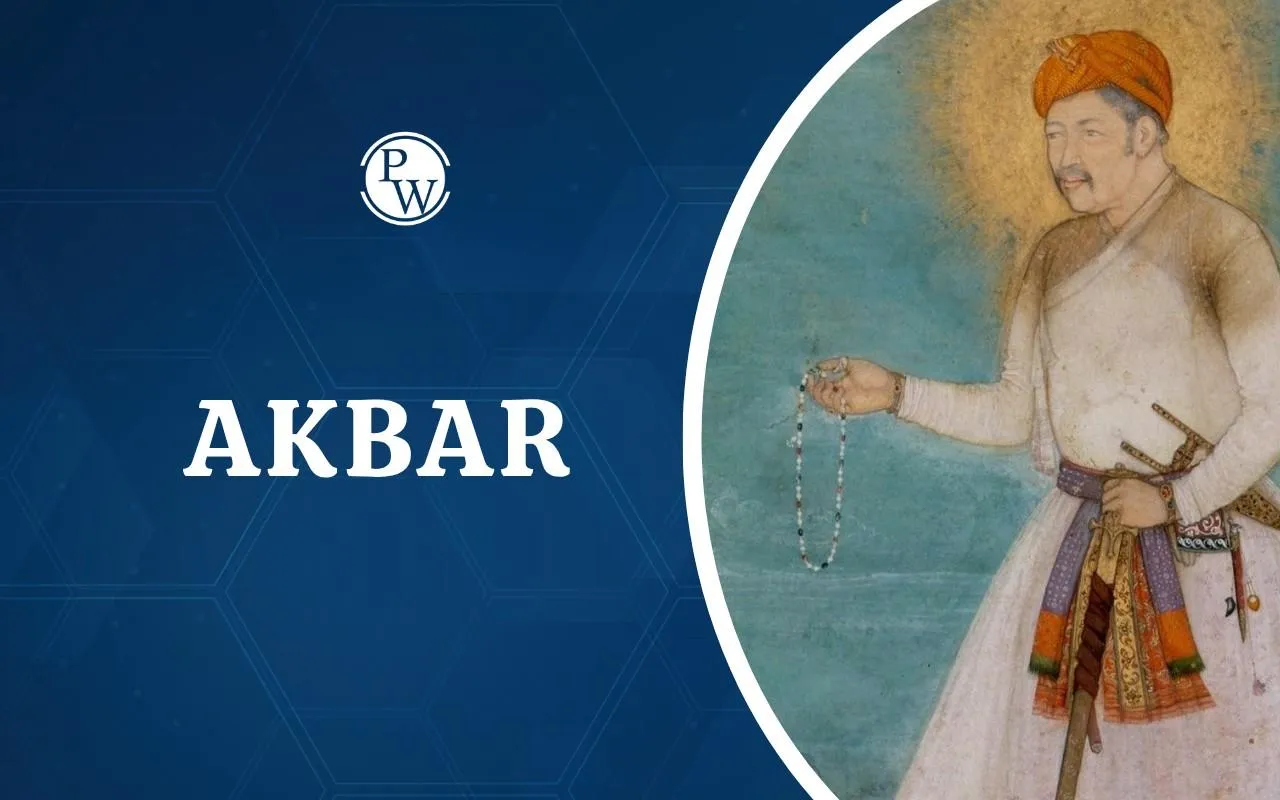

Akbar is known as one of the most powerful and wisest kings in Indian history. He reigned from 1556 to 1605 and built an empire on the principles of justice, equality, and understanding. Akbar was a true believer that all religions could coexist in peace.
His reign was not only marked by war and conquest, but also by art, learning, and culture. The Mughal Empire under Akbar became one of the wealthiest and most stable kingdoms in the world. He had a powerful army, loyal ministers, and content people.
Akbar Mughal emperor, was an open-minded man with a great curiosity about people, traditions, and ideas. His rule is often referred to as the “Golden Age of the Mughal Empire.” He built new cities, designed great buildings, and introduced new systems of administration.
Who was Akbar?
Akbar was the third Mughal emperor and the grandson of Babur, the founder of the Mughal dynasty. He was born on October 15, 1542, in Umarkot, Sindh (in present-day Pakistan). His father was the Emperor Humayun, and his mother was Hamida Banu Begum.
Akbar’s early life was filled with struggle. His family had lost power and his father had been dethroned. At the time of Akbar’s birth, he was a powerless wanderer. But he raised his son with courage and hope for the future. Akbar spent his childhood in deprivation and struggle, but destiny had bigger plans for him.

| Quick Facts about Akbar | |
| Information | Details |
| Akbar Full Name | Abu’l-Fath Jalal-ud-din Muhammad Akbar |
| Born | October 15, 1542, at Umarkot, Sindh |
| Father | Humayun |
| Mother | Hamida Banu Begum |
| Akbar Wife | Ruqaiya Sultan Begum, Salima Sultan Begum, Jodha Bai |
| Akbar Son | Prince Salim (later Emperor Jahangir) |
| Akbar Death | October 27, 1605, at Fatehpur Sikri |
| Buried | Akbar Jahan Tomb at Sikandra, Agra |
Akbar Biography
The Akbar biography depicts the life journey of an intelligent and kind-hearted man with immense courage. From his childhood, he showed the traits of a great leader. Although he did not learn to read or write, Akbar was full of information and was a sharp-witted boy. He had scholars, thinkers and poets around him who taught him about life, religion and politics.
In 1556, Akbar fought his first great battle, the Second Battle of Panipat. He faced the powerful Hindu general, Hemu, and emerged victorious, with the able assistance of Bairam Khan. It was this battle that made Akbar the true ruler of India. From that day forward, Akbar strived to expand and consolidate his empire.
Akbar conquered Gujarat, Bengal, Kashmir and parts of Central India. But, apart from military conquests, he also used the power of friendship and alliances to gain territory. He showed great respect to the Rajput kings and married a Rajput princess, Jodha Bai, to bring harmony between Hindus and Muslims.
Akbar was a great lover of learning and was deeply interested in different religions. He studied Islam, Hinduism, Christianity, Jainism and even Buddhism. He built a special house, known as the Ibadat Khana (House of Worship) in Fatehpur Sikri, where scholars from different religions would come and discuss their ideas in a peaceful atmosphere.
His policy of “Sulh-e-Kul” (peace for all) became the basis of his rule. The Akbar biography teaches us that wisdom, tolerance and compassion are the qualities that make a leader truly great.
Akbar Family
The Akbar family came from the famous Timurid and Mughal lineages. His grandfather was Babur, the first Mughal emperor, who brought the Mughal dynasty to India. His father, Humayun, was kind and gentle but faced many defeats. His mother, Hamida Banu Begum, supported him through every difficulty.
The Akbar family was royal but simple. Despite living in grand palaces, they valued relationships and respect. Akbar was very close to his mother and always took her blessings before battles.
He had many wives, but his marriage to Jodha Bai was the most special. Through this union, Akbar showed that love and respect could break barriers between religions. Akbar’s family later expanded when his son, Prince Salim, was born, who became Emperor Jahangir after him.
Akbar Administration
Akbar was a Mughal Emperor who had a strong administration that kept his empire in order. He created new revenue, military, and judicial systems to make them fair and effective. He also made policies that treated people of all religions equally and maintained peace, harmony, and discipline. The administration of Akbar was an example of a well-functioning and ideal government in India.
Key Features of Akbar’s Administration
-
Subahs or Provinces: Akbar divided his empire into several provinces known as Subahs. Each Subah was governed by a Subahdar, also known as a governor. The Subahs were further divided into Sarkars and Parganas.
-
Mansabdari System: Akbar had a system called Mansabdari for the officers and soldiers. Mansab means rank, and it determined the rank, salary, and number of soldiers an officer or soldier had to maintain. It brought organization and discipline in the army and the administration.
-
Revenue System: Akbar’s finance minister, Raja Todar Mal, implemented the Dahsala system that fixed the land tax on the average of ten years of crop yield. It made the tax system fair and less burdened on the farmers.
-
Judicial System: Akbar believed in justice and equality for all. He set up separate courts for civil and criminal cases and appointed honest and fair judges to deliver justice. He also heard the complaints and grievances of the common people in public places called Diwan-i-Aam and Diwan-i-Khas.
-
Religious Policy: Akbar followed the policy of Sulh-i-Kul or universal peace. He respected all religions and gave people the freedom to worship as they pleased. He also held discussions with the scholars and leaders of different religions to promote harmony and understanding.
-
Military System: Akbar had a powerful army that was divided into infantry, cavalry, artillery, and navy. He recruited soldiers from different parts of his empire and trained and disciplined them under the Mansabdari system. The soldiers were loyal to Akbar and his empire.
-
Trade and Economy: Akbar developed trade by building roads, rest houses, and ensuring safe and secure trade routes. His economic reforms led to increased trade, wealth, and prosperity in his empire.
-
Public Welfare: Akbar was a benevolent ruler who cared for his people and their welfare. He built schools, hospitals, and rest houses for his subjects and ensured they lived in peace and security.
-
Communication and Transport: Akbar established an efficient network of roads and postal systems that helped in the smooth running of the empire and quick communication.
-
Centralized Power: Although Akbar had a group of ministers and governors, he was the sole authority and made all the final decisions. His centralized control helped him in the effective management of his empire.
Akbar Battles
The Akbar Mughal Emperor fought many important battles to expand and protect his empire. These wars helped him unite most of India under one rule and made the Mughal Empire one of the strongest in the world. Akbar’s victories were not only due to his powerful army but also his clever planning, bravery, and respect for his enemies. Here are the major Akbar battles that shaped his reign:
Second Battle of Panipat (1556)
This was Akbar’s first and most important battle. It was fought between Akbar and Hemu, a Hindu general who wanted to take control of Delhi. Akbar’s army, led by Bairam Khan, defeated Hemu. This victory gave Akbar full control over Delhi and Agra and confirmed him as the ruler of the Mughal Empire.
Battle of Thanesar (1567)
Akbar fought against local chiefs in Haryana to bring peace to the region. This battle showed Akbar’s strength in maintaining law and order and expanding his empire in North India.
Siege of Chittorgarh (1567–1568)
One of Akbar’s most famous campaigns was against Rana Udai Singh of Mewar. Akbar attacked the fort of Chittorgarh, which was defended by Jaimal and Patta. After a long fight, Akbar captured the fort. This victory made him the master of Rajputana, although some Rajputs continued to resist him.
Battle of Ranthambore (1568–1569)
Akbar next attacked Ranthambore Fort, ruled by Raja Surjan Hada. The fort was very strong, but Akbar’s army used cannons and strong tactics to win. This battle further strengthened Mughal control over Rajasthan.
Battle of Gujarat (1572)
Akbar marched to Gujarat to stop the rebellion and gain control over important trade centres like Surat and Ahmedabad. After defeating the local rulers, Gujarat became part of the Mughal Empire. This also helped Akbar control the Arabian Sea trade routes.
Battle of Bengal (1574–1576)
Akbar sent his general Munim Khan to Bengal to defeat the Afghan rulers. Later, the Battle of Rajmahal (1576) was fought between Mughal forces and Daud Khan Karrani, the Afghan ruler of Bengal. The Mughals won, and Bengal came under Akbar’s rule.
Battle of Kabul (1581)
When Akbar’s half-brother Mirza Hakim, the ruler of Kabul, rebelled against him, Akbar led an army to Afghanistan. He defeated Mirza Hakim and brought Kabul under Mughal control. This victory helped protect India’s northwest border.
Battle of Kashmir (1586)
Akbar sent his army to conquer Kashmir, which was ruled by local kings. After a long struggle, Kashmir became part of the Mughal Empire. Akbar treated the people kindly and encouraged peace in the region.
Battle of Sindh (1591)
Akbar sent Abdul Rahim Khan-i-Khana to conquer Sindh. The Mughal army defeated the rulers of Thatta and made Sindh part of Akbar’s empire. This battle helped secure trade through the Indus River.
Battle of Deccan (1596–1601)
Akbar wanted to expand southwards, so he fought against the rulers of Ahmadnagar, Khandesh, and Berar. His generals, including Abul Fazl and Prince Murad, played important roles. The capture of Asirgarh Fort in 1601 marked Akbar’s final major victory.
Akbar 9 Jewels Name
Akbar’s court included many of the greatest intellectuals of his time. The nine most talented men in his court were known as the Navratnas or the 9 jewels of Akbar. These nine gems advised Akbar, and they helped him run his kingdom. They created art, wrote books, and made wise decisions.
-
Abul Fazl: Chief advisor and author of Akbar Nama, the official biography of Akbar.
-
Faizi: Poet laureate and mentor of Akbar’s sons, famous for his elegant Persian poetry.
-
Tansen: Legendary singer and musician, who made Akbar’s court the centre of musical excellence.
-
Birbal: A Witty and clever courtier who served as Foreign Minister and solved problems with humour and intelligence.
-
Raja Todar Mal: Finance Minister, who devised a very efficient land revenue system.
-
Raja Man Singh: Chief of Staff of Akbar’s army, and a brave and noble Rajput general.
-
Abdul Rahim Khan-I-Khana: Defence Minister and poet, known for his wisdom and knowledge.
-
Fakir Aziao-Din: Religious Minister, who advised Akbar on spiritual and religious matters.
-
Mulla Do Piaza: Home Minister and advisor, known for his quick wit and intelligence.
Akbar Architecture List
Akbar was a patron of art and architecture. His buildings reflected his sensuous appreciation of beauty, symmetry, and creativity. He combined Persian, Indian, and Islamic styles to develop a unique architectural style. A list of some of the most famous monuments built during the reign of Akbar is as follows:
-
Fatehpur Sikri: Akbar built this imperial city near Agra as his new capital. It is a complex of palaces, courtyards, and mosques made of red sandstone.
-
Buland Darwaza: The “Gate of Victory” built to commemorate Akbar’s victory over Gujarat. It is one of the highest gateways in the world.
-
Agra Fort: A huge fort built of red sandstone, it served as the residence of the Mughal emperors.
-
Akbar Jahan Tomb: Akbar’s tomb at Sikandra near Agra is a beautiful example of Mughal architecture, where creativity and tranquillity meet.
Akbar's architecture list, which shows his love and care for design, beauty, and innovation. His structures remain as a testimony of India’s golden past.
Akbar Death
Akbar's death occurred on 27 October 1605, at Fatehpur Sikri, after a brief illness. He was 63 years old and had been ruling India for almost five decades. His death was a great loss to the empire, and it was mourned by all.
He was buried in his own tomb, the Akbar Jahan Tomb, at Sikandra, near Agra. The tomb is located in a large garden and is designed to reflect Akbar’s personality – grand, serene, and eternal.
After Akbar's death, his legacy continued to live on through his ideas and policies. His successors, his son Jahangir and grandson Shah Jahan, carried forward his vision of peace, tolerance, and justice.
Akbar’s Legacy
Akbar’s reign had a profound impact on India and its people. He demonstrated that a ruler’s true power lies not in fear but in justice. He brought people of all faiths and regions together under one flag.
He abolished religious taxes, respected local customs, and granted religious freedom to all. He also boosted trade, improved infrastructure, and promoted agriculture, making the Mughal Empire prosperous and strong.
Akbar’s vision of “peace for all” won him the love and admiration of his subjects. His idea of India as a land of harmony continues to inspire generations.
